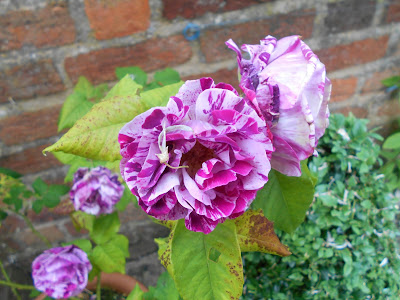I am fond of neat and colourful rock garden plants (many so-called alpines are nothing of the sort and 'rock garden plants' is a conveniently all-embracing term).
The thymes in our front garden are spreading with such enthusiasm that I'll have to deal with them come next muck-spreading but the bees - I counted fourteen of them on a biggish patch recently - are so fond of them that the flowers are safe for the moment.
 |
Thymes have developed to take a dominant position in our front garden.
15 July, 2018
|
Another neat little plant (which can also spread alarmingly) is the dainty bellflower, Campanula cochleariifolia. Its tubby little bells have earned this plant, native to the mountains of south-central Europe, the name of Fairies Thimbles.
 |
Campanula cochlearifolia receives occasional visits from bees.
Our fron garden. 15 July, 2018
|
At the other end of the scale are the Eremurus species, aka Foxtail Lilies. They too are mountain plants but one would hesitate to call them alpines. Ranging from Turkey to China they seem to occupy stony soil but some species can reach a height of ten feet, so presumably the soil needs to be nutrient rich. Our specimen is currently six feet tall but may yet grow a little. It is probably Eremurus bungii or one of its hybrids but the label has gone astray. Its colour is bright orange and the photograph fails to do it justice.
 |
Foxtail Lilies can be a dramatic feature of a garden
border. 14 June, 2018
|
Foxtail Lilies have only recently gained popularity, perhaps because their reputation for being tricky is only now being overcome.
I also grow an old favourite, Heliotrope, Heliotropium arborescens. It is a member of the Borage family and is toxic - if you go around munching mouthfuls! But it is its fragrance rather than its toxicity which make this tender annual so desirable. As with many plants such as honeysuckle, the fragrance becomes intense as evening approaches and, unsurprisingly, it receives many visits from moths (or it used to a few decades back). It has nothing whatever to do with the Winter Heliotrope, a member of the Daisy Family, other than having a rich fragrance.
I also grow an old favourite, Heliotrope, Heliotropium arborescens. It is a member of the Borage family and is toxic - if you go around munching mouthfuls! But it is its fragrance rather than its toxicity which make this tender annual so desirable. As with many plants such as honeysuckle, the fragrance becomes intense as evening approaches and, unsurprisingly, it receives many visits from moths (or it used to a few decades back). It has nothing whatever to do with the Winter Heliotrope, a member of the Daisy Family, other than having a rich fragrance.
 |
Heliotrope is an old favourite. Our garden at Stefen Hill, Daventry.
15 June, 2018
|
Another old favourite is the rose 'Variegata di Bologna'. Peter Beales, the famous rosarian, once described the colour of the petals as 'blackcurrant jam stirred into semolina'. It has gorgeous flowers with a heavy, old-rose scent but my specimen isn't performing as well as it should. It is almost certainly my own fault because I am growing it in a pot and have not fed it sufficiently.
 |
| 'Variegata di Bologna' in our back garden. 14 June, 2017 |

No comments:
Post a Comment